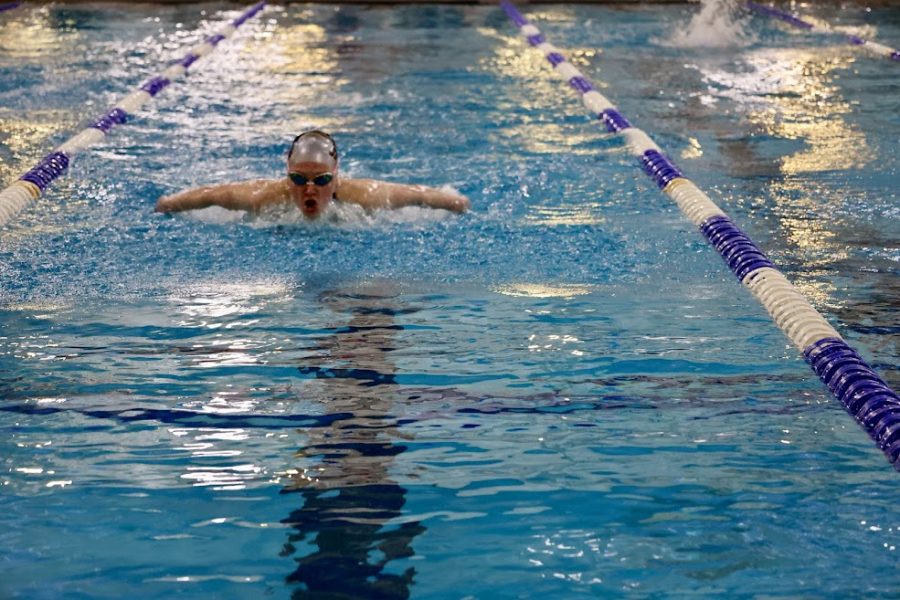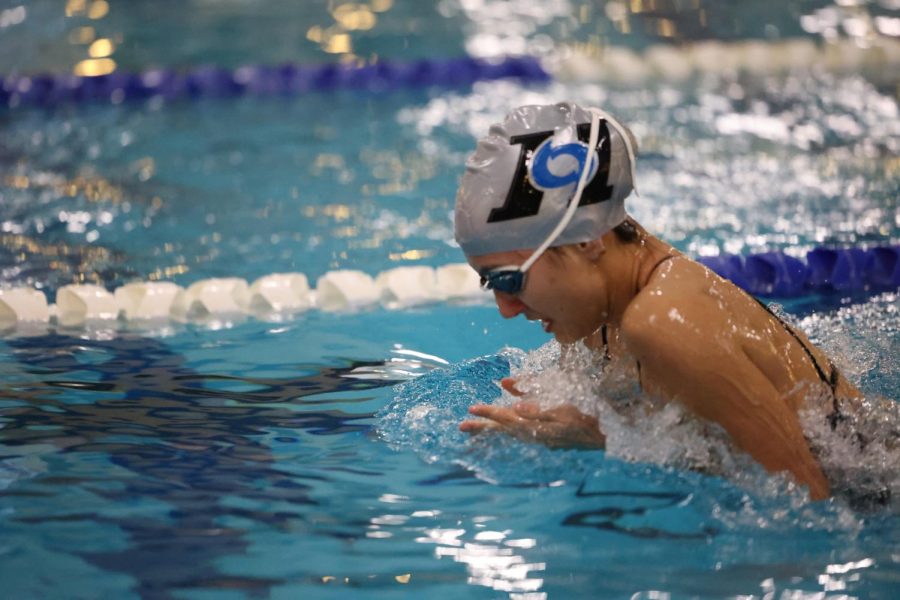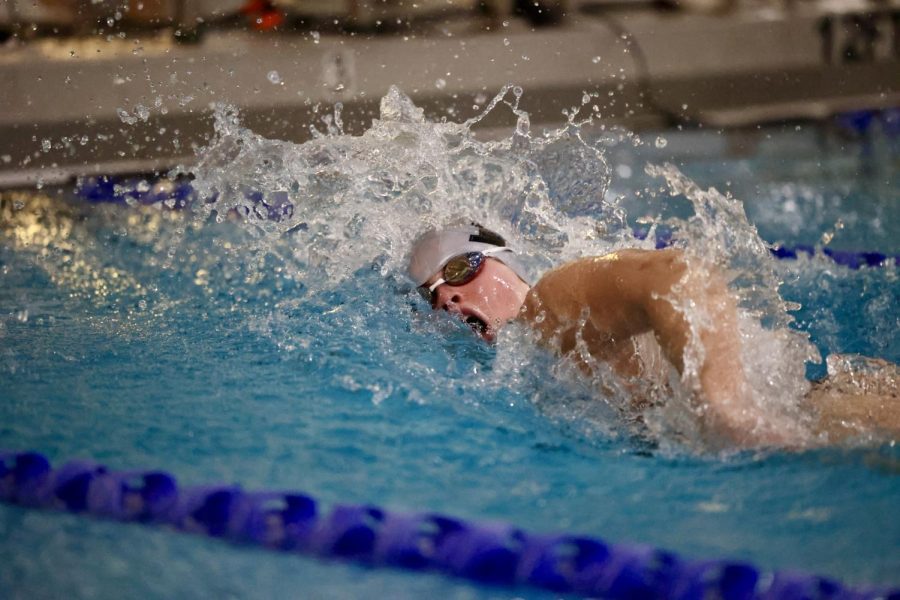The Thoughts of a Clueless Viewer: Swimming Edition
February 18, 2022
“Where is the entrance?” I think to myself as I survey an unfamiliar campus that is St. Charles High School. All I have is an address so I do what any logical person would do and drove around in circles, reading signs above entrances until I ended up in front of one that read “Aquatic Center.” The walk from the car to the front door is unforgiving, my face being chilled by a light breeze making the cold just that much worse. The cold only lasts so long before I enter the pool area and am greeted by a wall of humidity and an intense chemical smell.
I find myself a seat in the rows of bleachers left of the pool and begin watching, until they get to the finish and another jumps in. Eventually, the cycle is over, and I hear the woman in front of me tell another man, “They just finished the boys’ single medley.” Which, if I remember correctly, is four swimmers, each with a different stroke.
No more than 30 seconds after the finish of the first race, I hear the buzzer go off and another group begins to swim. I assume the race is the girls’ medley because that is what seems to make sense. I notice the silver and black caps the swimmers wear as they move through the water swiftly. This is before my attention is stolen by the two mostly white basketball hoops on either side of the lap pool which I find funny because you’d figure those would be moved during a meet.
After the girls’ medley finishes there is a much longer pause between it and the next race. In this race, there are only three boys. Two from Huntingtown and one from St. Charles. They begin their race flying down the lanes and heading back to what I think is the finish before going for another lap. This continues for the next 3 laps before they are out of the pool and a group of 6 girls are lined up and ready to go. This time, three members from each team. I wonder if they are participating in the same event as the boys were previously. After the turnaround for the second lap, my assumption becomes clearer. This allows me to understand the pattern of the swim meet. Boys participate in an event and the girls follow up with the same one, alternating until they get through all 16 of the events. Now that I have that understanding, I can better focus on the swimming itself and take note of the peaceful strokes, which I assume is to preserve endurance throughout the event.
This is the part where my viewing location is changed from the stands to the sidelines. Once I am on the sideline, I am able to attain information as I watched. Buzzer. A group of boys dives into the water. “This is the 200 IM, it’s 50 butterfly, 50 backstroke, 50 freestyle,” Lincoln Johnson says. “That’s in yards by the way.” As we watch from a slight distance a Huntingtown boy takes an early lead. “Micah is flying on his fly.” Fly must be short for butterfly.

The next event takes off quickly. These swimmers are not as peaceful as the girls were. They go down and back once and that’s the race. “That’s 100 free,” Junior Olivia Hudson says before I quickly inform her, with a sense of pride in my ability to retain the recent information, that it was actually 50 free. The race ends, and the group of girls following is also moving with great efficiency, also with a more violent stroke than in the earlier race. This is when I make the connection that the smoother and more peaceful the stroke the further you must be swimming, but as you begin targeting speed, the stroke will become more violent.
“The pool is not refreshing,” Madelyn Bren informs me, which doesn’t come as much of a shock as the climate of the indoor pool building is not pleasant.
The swimming has been at a stop for a few minutes before Micah Krenik says, “This is a break. Did you know that… Extra Practice.” Although he said extra practice, it appears most people truly use it as a break rather than getting a couple of extra laps in.
Breaks over. Back to competing. The first race back is a 100 “fly.” This is also the first time I really take notice of the dives at the beginning and how far out the swimmers are able to get from a still position. “Can you cap me?” Olivia Hudson asks Madelyn Bren as she hands over her swimming cap. Madelyn quickly slips it over Olivia’s hair and she’s off to the start line for the women’s 100 fly.
As the meet goes on and the swimmers tell me what each event is called, I can’t help but wonder how they always know exactly which event is happening just from a quick glance at the pool. “It’s always in the same order so we just remember it,” Madelyn informs me.
I look out at the water as the girls’ 100 freestyle is occurring. I notice the effortless form of the swimmers. This made me think about my own swimming form and how the sport is about more than just swimming up and back, you have to be able to use your energy appropriately to be at the right pace. “It’s like track in the water,” Lincoln says as I begin instantly agreeing with him. As someone with a running background, I can relate the two together.

Upcoming is the longest event of the whole night, an event that can “take up to 8 minutes,” the 500. A race that shows off one’s mental and physical toughness. Something I wouldn’t want to put myself through. It seems they all dreaded the race, from those swimming in it to those watching it. The girls’ 500 takes place right after. “The one thing I do like about the 500 is I can just swim without thinking about lap count,” Madelyn tells me before heading over to where she would begin her 500 from. This is because at the end of each lane they have a teammate sitting with a board counting each lap for them from one to twenty.
Watching the next few races, I try to be more observant of the more technical stuff rather than the form and the event name: things like the quickness of your dive or the way a swimmer approaches a wall, how much do these things affect their times?
The final event is approaching, the girls and boys 4×100 freestyle. Four swimmers, each going 100 yards, all swimming the same stroke. There is some noise around me that is quickly stopped by a whistle. “You can’t be loud after the whistle,” says Emma Bhien. I think about how there is etiquette in each sport and that must be one of the rules of swim etiquette.

After the experience of my first swim meet, I came away feeling much more knowledgeable about the sport and had also developed more refined respect for swimmers now seeing what they endure through a meet. The experience did not only increase my knowledge of the sport but also inspires me to want to go learn and view other sports around Huntingtown that I wouldn’t normally.

